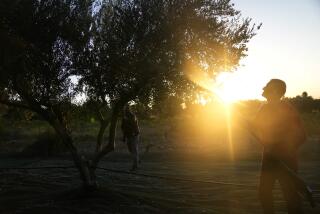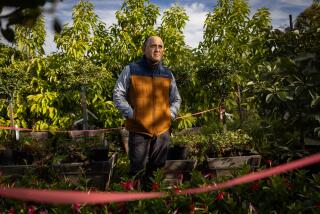Charley deals bitter blow to citrus growers
As Ellis Hunt maneuvered his Chevy Tahoe around twisted citrus trees Tuesday, Hurricane Charley’s impact on Polk County’s citrus industry could be felt in the still-green fruit bursting under his tires.
As much as 90 percent of Hunt’s grapefruit crop, still a couple months from harvest in the state’s No. 1 citrus-producing county, lay on the ground. Navel, Valencia and Hamlin oranges and honey tangerines also were slammed by Charley’s 115-mph winds, dealing a bruising blow to Central Florida’s last citrus powerhouse.
“If there’s enough damage to raise the price of the remaining crop then you’ll have to make a decision if there’s enough to go in and pick it,” said Hunt, president of Hunt Brothers Inc. But for many of the groves the economics won’t work -- there won’t be enough fruit on the trees to make it worth picking, Hunt said.
“It’s much worse than a freeze,” said Florida Agriculture Commissioner Charles Bronson, who toured Polk County on Monday. Bronson said he saw growers’ barns, homes and equipment damaged in addition to their crops.
When the impact is tallied in the weeks to come, “a lot of these guys are going to have to make a real serious determination of what they’re going to do,” Bronson said. “This is one of those things that can break the camel’s back.”
Nobody ventured a guess at the total citrus toll, wanting to wait a few more weeks to see how much more fruit falls from trees.
“Right now, we’re giving citrus-grove owners time to get back to their normal lives before we can get a better determination,” said Casey Pace, a spokeswoman for Florida Citrus Mutual, an industry group that represents about 11,000 growers.
A ripple effect will be felt later this year when migrant pickers return for the harvest and struggle to find work, Bronson said.
Gov. Jeb Bush, after stops Tuesday in Lake Wales and Bartow, said agriculture will take a big share of the hit in what is shaping up to be the second-most expensive storm in the country’s history.
“The agriculture sector is so vital to our state,” Bush said. “The storm will have a major economic impact . . . especially [on] the citrus industry.”
As Charley cut a path through the center of Florida, it put at risk about 300,000 acres -- or 35 percent -- of the state’s citrus crop, said Andrew Meadows, a spokesman for the Florida Department of Citrus.
The state has a total of about 800,000 acres of citrus trees. Of that, Polk is the top-ranked citrus-producing county with about 101,000 acres. Lake is 13th with 18,800 acres, Osceola is 14th with 14,300 acres and Orange 21st with 6,800 acres.
Growers, like so many of their neighbors, have spent their post-Charley days cleaning up at their homes, leaving little time to check the crops.
Floyd DeVane, a third-generation citrus grower, estimated he lost half of his crop to Charley. His Fort Meade groves looked as if a pack of giants had stomped through them.
The damage Hurricane Donna wreaked in 1960 was nothing compared to Friday night’s storm, DeVane said. He estimated it would take several years for business to recover. But growers say Charley merely made a bad situation worse.
Low prices have kept profits to a minimum for the past few years. And the prospect of soon losing a protective tariff on Brazilian citrus had the 74-year-old grower shake his head in disgust.
“If they do away with it, it doesn’t matter what you do in the grove,” DeVane said. “You’re dead.”
Martin E. Comas and Monica Scott of the Sentinel staff contributed to this report. Christopher Sherman can be reached at csherman@orlandosentinel.com or 863-422-3395. Vicki McClure can be reached at vmcclure@orlandosentinel.com or 352-742-5928.
More to Read
Start your day right
Sign up for Essential California for news, features and recommendations from the L.A. Times and beyond in your inbox six days a week.
You may occasionally receive promotional content from the Los Angeles Times.






